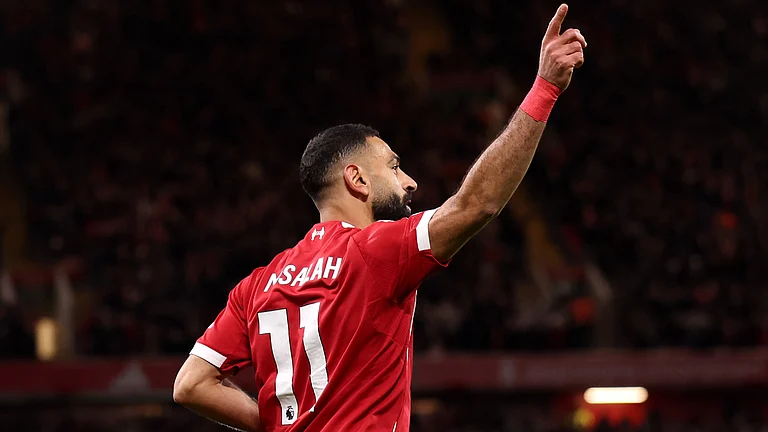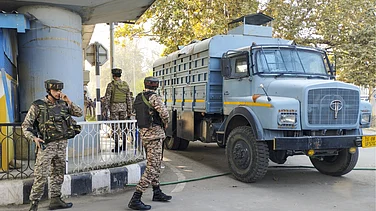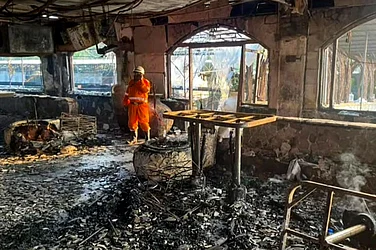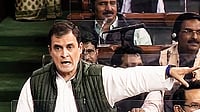Ahead of the assembly elections in Uttar Pradesh, the Dalit-run YouTube channel The Shudra uploaded a news item on Dalit basket-weavers of Azamgarh. Coming in the midst of the election season, the news defied logic of the mainstream media—chasing stale bytes of leaders and digging for dead numbers from past elections. “We found basket weavers of the Dalit community living in extremely deplorable conditions. They wove the baskets with a lot of effort, and they were generally bartered for little goods. They are not even paid for that,” says Sumit Chauhan, founder of The Shudra. “We kept our focus on issues like this and tried to disseminate them through our online media. These were the kind of stories we needed to highlight.”
Sumit realised the need for his own YouTube channel when he was six years into working in a mainstream TV organisation. During this period, Sumit recalls many instances of discrimination, including being overlooked for promotion and having his story ideas trashed. “I joined the newsroom after completing my journalism course from the Indian Institute of Media and Communication. Coming from there and making a place in a leading TV news channel was a significant achievement. It was exciting for me and also for my family. I am a Chamar by caste, and my grandfather was in the business of repairing shoes. This was a big leap from there,” Sumit tells Outlook. But very soon, his ideal world of journalism started to crumble as he faced the harsh realities of a casteist society and an industry dominated by upper castes.
“It did not take very long for me to realise that the work I was doing will not bring any change in the life of the weak and marginalised people. It would instead help those who believe in maintaining the status quo. After the Una incident—when seven Dalits were assaulted over a cow-related incident in 2016—I had pitched an idea around it to my editor, and it was rejected. I went to the canteen and expressed my displeasure; this was when someone said, Kutton ko aur Daliton ko ghee nahi khilatein (Dogs and Dalits are not fed ghee). That was when I realised that I had to move on from here,” he says. After quitting the organisation, he jumped from one job to another till he finally found his calling in 2020.
“I started my own YouTube Channel called The Shudra while working with another organisation. I hid my identity and did not come on camera while working there. Meanwhile, as I started to talk about Dalit issues from a Dalit perspective, my channel started gaining traction. I already had around three lakh subscribers when I decided to quit my job and dedicate full time to the channel.” The Shudra now has more than one lakh followers on Twitter.
The Shudra’s story is one among many such similar tales of Dalit pushback against caste bias in the media industry. Dozens of Dalit journalists have started their own YouTube channels and websites, having failed to find a space in mainstream media, to become the voices of the community. Several alternative media and Dalit organisations report extensively on Dalit issues, like Round Table India, Dalit Dastak, Dalit History Month, Velivada, Dalit Camera, Dr BR Ambedkar’s Caravan, Dalit Feminist, Dalit Women Fight, The Dalit Voice and SRE News, among others. And in the just-concluded elections, these alternative voices looked at stories from a perspective far removed from the mainstream narratives. For another Bahujan media organisation, National India News, the strategy and focus of the coverage was to revisit the five-year manifesto (Bahujan specific) of the governments in power. “Our team travelled in remote areas of Punjab and Uttar Pradesh to capture the mood of specific seats. In Uttar Pradesh, our reporter covered stories mainly on health infrastructure since the pandemic, unemployment, education, and atrocities on the Bahujans and Muslims,” says Anwarul Huda, the managing editor of the organisation. “Our idea was to show stories on promises vs reality. We believe that tracking the promises made in manifestos is the best way to educate our viewers about governance. We believe in empowering our viewers with the information so that they can take decisions rationally.”
Manish Kumar, who runs SRE News from Saharanpur, has a story resonating with Sumit’s. Manish, too, worked with a news channel as a reporter from Saharanpur. However, the coverage of the 2017 violence in Saharanpur between Bhim Army members and others disturbed Manish, and he decided to quit. “I was working with a TV channel till 2017, but the way it covered the violence in Saharanpur and shifted the blame on the Dalit community for instigating the violence disturbed me. This was not objective reporting, and I realised I had to start a YouTube channel that does factual reporting from the ground when it came to Dalits and other marginalised communities,” he tells Outlook.

SRE TV, born in 2017, now has over one lakh followers on YouTube and Facebook and, like The Shudra, reports on Dalit issues. However, Dalit media is not new; it has its roots in the early 19th century when the country was witnessing a surge in nationalist movement against British colonialism. Since the 1920s, Dalit journalism has grown in popularity. The Mahad agitation of 1927 ushered in a new era of aggressive and affirmative mass politics. The movement was a conspicuous example of Dalits being denied access to public venues and regularly subjected to upper-caste violence. “Dalit leaders recognised that mainstream media would reinforce traditional caste beliefs, necessitating creating a separate media outlet. On January 31, 1920, Mooknayak became the first journal to appeal to the oppressed classes. It lasted three years before being replaced by Bahishkrut Bharat in 1927. During the 1920s, Mooknayak and Bahishkrut Bharat took a strong stand on several sensitive religious, social, and political topics. In the late 1920s, these periodicals were crucial in mobilising public opinion against caste violence,” explains Raees Mohammad, founder of Dalit Camera.
However, Raes Mohammad also claims that there has been a shift in Dalit media. “Dalit media started as a tool to educate Dalits. However, more recently, Dalit channels cater to a broader audience that is not necessarily educated class. Today’s Dalit media is a little different in its aims at mass awareness and not just intellectual debates and education. We at Dalit media also address the question of divisions within the Dalit community and do not consider it as one homogenous group,” Raes adds.
ALSO READ: Media And Manipur: Courage Under Fire
Available data on the subaltern representation in mainstream media corroborates the claims of Sumit and Manish. According to a recent Oxfam and NewsLaundry study, people from the upper caste hold 100 per cent of leadership positions in Hindi television news, 89.3 per cent in English television news, 91.7 per cent in English newspapers, 87.5 per cent in Hindi newspapers, 84.2 per cent in digital media, and 72.7 per cent in news magazines. In addition, the survey shows that Dalits are absent from critical positions in India’s news media. Most anchors, panellists, and writers come from the upper classes. Except for the Hindi newspaper Amar Ujala, mainstream media has more than 50 per cent of anchors and writers from higher castes reporting on caste issues.

In the mid-1990s, journalist Chandra Bhan Prasad and Sheoraj Singh Bechain drafted and sent to the Press Council of India and the Editors’ Guild a memorandum titled ‘End Apartheid from Indian media: Democratise Nation’s Opinion’, advocating that media in India adopt a model similar to the American Society of News Editors, considered a barometer of democracy in newsrooms. The council is reported to have stated that the media is owned and operated by the private sector, thus outside its control. The Editors’ Guild allegedly also did not respond to the request.
Despite the growth of alternative Dalit media in the backdrop of absence of Dalits from mainstream media and allegations of discrimination, most of these small organisations suffer from financial issues. “We do not have enough funds to establish a big team. We mainly depend on earnings from social media channels and some support from the community. Revenues from social media platforms are not enough to keep the organisation afloat. The funding agencies do not find our reporting and exclusivity very appealing,” Sumit says. Raes explains that the problem with funding again has been historically associated with Dalit media organisations. “The problem of finances again has been historically associated with Dalit media, the community does not have enough resources to support these organisations, and funding agencies again do show an interest in these ventures,” Raes says.
Regarding reporting on elections, both Sumit and Manish assert that they look at elections like everything else, with a Dalit perspective. “Say, if we are reporting on the economy, we will try to figure out a Dalit perspective into it and see what impacts the community. Similarly, on social and political issues that we report on, there is an element of Dalit interest. Dalit media does not mean that we only report on Dalit issues, but yes, we report it from the perspective of Dalits,” says Manish. These organisations extensively reported on the just-concluded assembly elections. Their ground reports during the elections also focused on leaders, campaigns, and issues of the Dalit community. As of writing this, on the home page of The Shudra, seven out of the top eight stories are on elections, and five of them are about Dalit leaders like Mayawati and Chandrashekhar Azad; the others are on security of EVMs. Similarly, the SRE News’ focus during the elections were leaders of the Dalit community and reports from Dalit colonies and villages.
ALSO READ: Dial M For Media: The New Muslim Voice
On being asked if this kind of reporting was not ghettoising the community further, Manish says, “We are already ghettoised, compelled to live in certain localities. Our work is now creating awareness among the people on how they have been pushed to the margins. During elections or at any other point of time, our kind of reporting is to empower the Dalits through information.” There have also been discussions over the quality of journalism practised by Dalit media outlets and the need to keep up with the competition.
In a column for The Hindu, Robin Jeffrey, a Canadian-born professor whose primary research interest is India’s modern history and politics, had suggested that Dalits need a first-class publication. Like the African-American-focused magazines Ebony and Essence in the United States, it should offers alternative viewpoints to the mainstream. It should be compelling enough that others would want to read it for its classiness and diversity, he adds.
But Manoj Antani of Samta Awaz TV asserts that these Dalit voices are no longer alternative media. “We are the real media…It is not long before our viewership will surpass the so-called ‘mainstream media’. They are as dependent on YouTube as we are; it is just that their studios are fancier. They can pump in more money than us, but it’s only a matter of time before people’s power will overshadow money power, and we will create more impact than them.”
(This appeared in the print edition as "Songs of the Subaltern")
ALSO READ

























